opencv中提供findContours()函数来寻找图像中物体的轮廓,并结合drawContours()函数将找到的轮廓绘制出。首先看一下findContours(),opencv中提供了两种定义形式
官网:https://docs.opencv.org/3.3.1/d3/dc0/group__imgproc__shape.html#ga17ed9f5d79ae97bd4c7cf18403e1689a
void cv::findContours ( InputOutputArray image,
OutputArrayOfArrays contours,
OutputArray hierarchy,
int mode,
int method,
Point offset = Point()
)
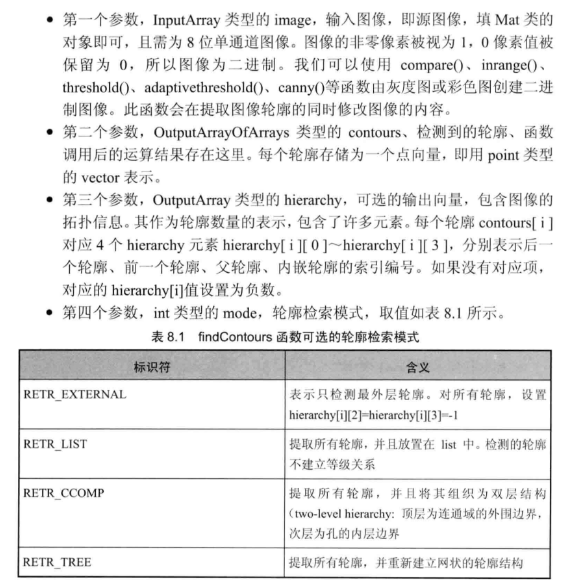
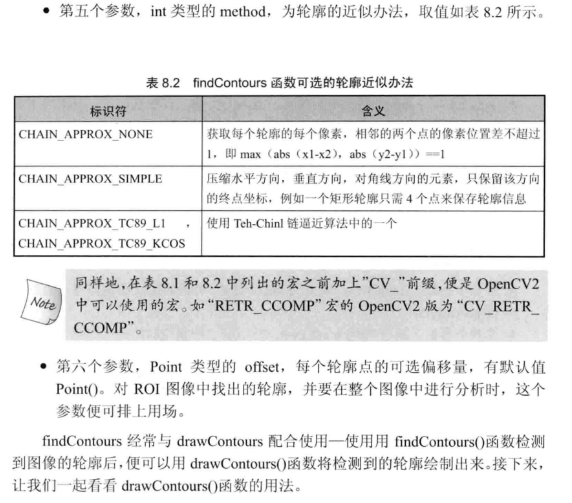
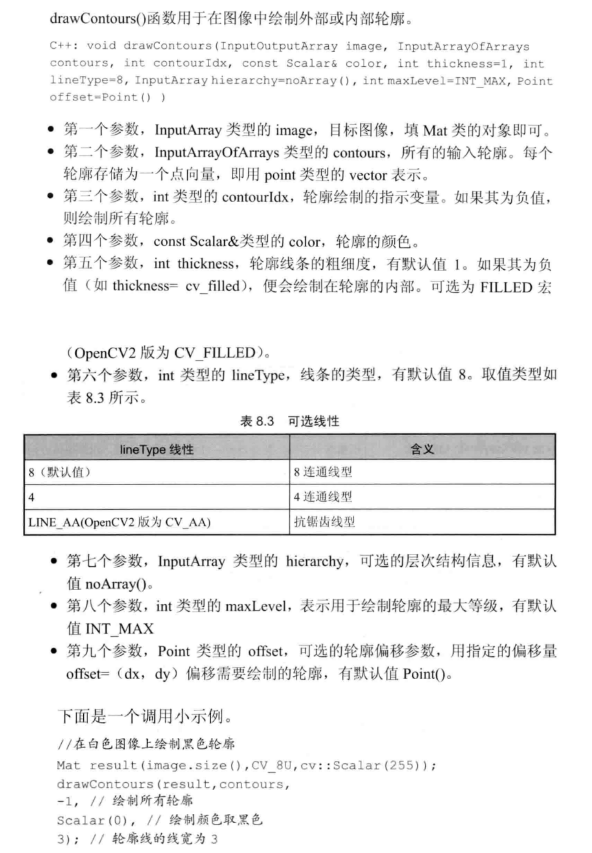
#include "opencv2/highgui/highgui.hpp"
#include "opencv2/imgproc/imgproc.hpp"
#include <iostream>
#include <stdio.h>
#include <stdlib.h>
using namespace cv;
using namespace std;
Mat src; Mat src_gray;
int thresh = 100;
int max_thresh = 255;
RNG rng(12345);
/// Function header
void thresh_callback(int, void*);
/** @function main */
int main(int argc, char** argv)
{
/// 加载源图像
src = imread("E:\\VS2015Opencv\\vs2015\\project\\picture\\07.jpg", 1);
/// 转成灰度并模糊化降噪
cvtColor(src, src_gray, CV_BGR2GRAY);
blur(src_gray, src_gray, Size(3, 3));
/// 创建窗体
char* source_window = "Source";
namedWindow(source_window, CV_WINDOW_AUTOSIZE);
imshow(source_window, src);
createTrackbar(" Canny thresh:", "Source", &thresh, max_thresh, thresh_callback);
thresh_callback(0, 0);
waitKey(0);
return(0);
}
/** @function thresh_callback */
void thresh_callback(int, void*)
{
Mat canny_output;
vector<vector<Point> > contours;
vector<Vec4i> hierarchy;
/// 用Canny算子检测边缘
Canny(src_gray, canny_output, thresh, thresh * 2, 3);
/// 寻找轮廓
findContours(canny_output, contours, hierarchy, CV_RETR_TREE, CV_CHAIN_APPROX_SIMPLE, Point(0, 0));
/// 绘出轮廓
Mat drawing = Mat::zeros(canny_output.size(), CV_8UC3);
for (int i = 0; i< contours.size(); i++)
{
Scalar color = Scalar(rng.uniform(0, 255), rng.uniform(0, 255), rng.uniform(0, 255));
drawContours(drawing, contours, i, color, 2, 8, hierarchy, 0, Point());
}
/// 在窗体中显示结果
namedWindow("Contours", CV_WINDOW_AUTOSIZE);
imshow("Contours", drawing);
}
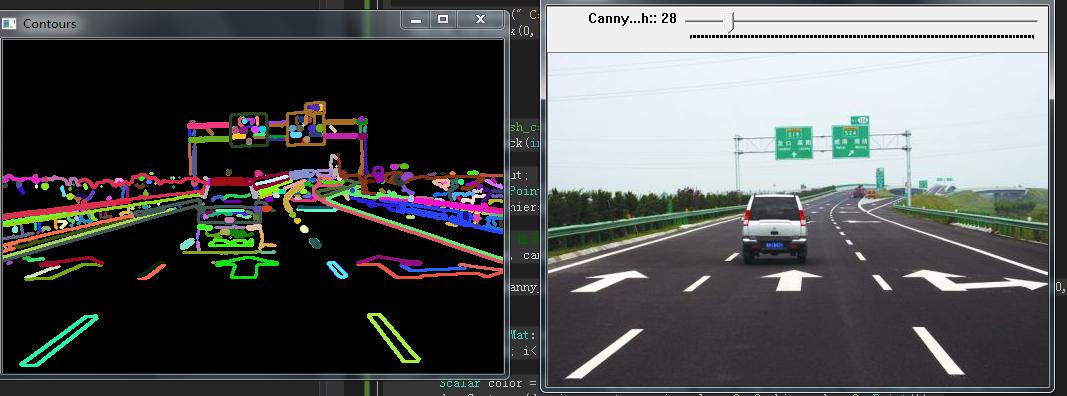
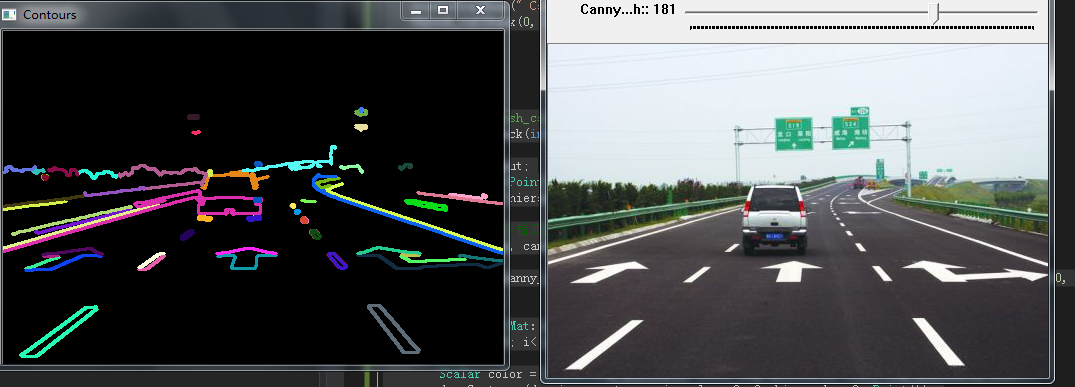
OpenCV提取轮廓之后,还可以进行许多操作:
ArcLength() 计算轮廓长度
ContourArea() 计算轮廓区域的面积
BoundingRect() 轮廓的外包矩形
ConvexHull() 提取轮廓的凸包
IsContourConvex() 测试轮廓的凸性
MinAreaRect() 轮廓的最小外包矩形
MinEnclosingCircle() 轮廓的最小外包圆
fitEllipse() 用椭圆拟合二维点集
approxPolyDP() 逼近多边形曲线
boundingRect函数简介
boundingRect函数是用来计算轮廓的最小外接矩形,通常与findContours函数组合使用,findContours函数用来查找图像的轮廓,boundingRect获取轮廓的最小外接矩形!
Rect boundingRect( InputArray array );
(1) 第一个参数,InputArray array,一般为findContours函数查找的轮廓,包含轮廓的点集或者Mat;
(2) 返回值,Rect,返回值为最小外接矩形的Rect,即左上点与矩形的宽度和高度;
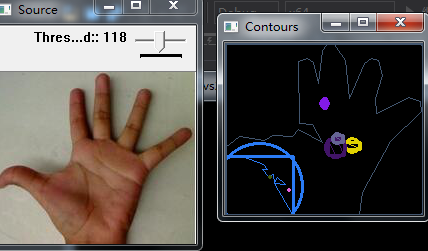
#include "opencv2/highgui/highgui.hpp"
#include "opencv2/imgproc/imgproc.hpp"
#include <iostream>
#include <stdio.h>
#include <stdlib.h>
using namespace cv;
using namespace std;
Mat src; Mat src_gray;
int thresh = 100;
int max_thresh = 255;
RNG rng(12345);
/// 函数声明
void thresh_callback(int, void*);
/** @主函数 */
int main(int argc, char** argv)
{
/// 载入原图像, 返回3通道图像
src = imread("E:\\VS2015Opencv\\vs2015\\project\\picture\\1.1.jpg", 1);
/// 转化成灰度图像并进行平滑
cvtColor(src, src_gray, CV_BGR2GRAY);
blur(src_gray, src_gray, Size(3, 3));
/// 创建窗口
char* source_window = "Source";
namedWindow(source_window, CV_WINDOW_AUTOSIZE);
imshow(source_window, src);
createTrackbar(" Threshold:", "Source", &thresh, max_thresh, thresh_callback);
thresh_callback(0, 0);
waitKey(0);
return(0);
}
/** @thresh_callback 函数 */
void thresh_callback(int, void*)
{
Mat threshold_output;
vector<vector<Point> > contours;
vector<Vec4i> hierarchy;
/// 使用Threshold检测边缘
threshold(src_gray, threshold_output, thresh, 255, THRESH_BINARY);
/// 找到轮廓
findContours(threshold_output, contours, hierarchy, CV_RETR_TREE, CV_CHAIN_APPROX_SIMPLE, Point(0, 0));
/// 多边形逼近轮廓 + 获取矩形和圆形边界框
vector<vector<Point> > contours_poly(contours.size());
vector<Rect> boundRect(contours.size());
vector<Point2f>center(contours.size());
vector<float>radius(contours.size());
for (int i = 0; i < contours.size(); i++)
{
approxPolyDP(Mat(contours[i]), contours_poly[i], 3, true);
boundRect[i] = boundingRect(Mat(contours_poly[i]));
minEnclosingCircle(contours_poly[i], center[i], radius[i]);
}
/// 画多边形轮廓 + 包围的矩形框 + 圆形框
Mat drawing = Mat::zeros(threshold_output.size(), CV_8UC3);
for (int i = 0; i< contours.size(); i++)
{
Scalar color = Scalar(rng.uniform(0, 255), rng.uniform(0, 255), rng.uniform(0, 255));
drawContours(drawing, contours_poly, i, color, 1, 8, vector<Vec4i>(), 0, Point());
rectangle(drawing, boundRect[i].tl(), boundRect[i].br(), color, 2, 8, 0);
circle(drawing, center[i], (int)radius[i], color, 2, 8, 0);
}
/// 显示在一个窗口
namedWindow("Contours", CV_WINDOW_AUTOSIZE);
imshow("Contours", drawing);
}
minAreaRect()
作用:找到一个能包围输入二维点集的面积最小的任意方向矩形。
形式:minAreaRect(InputArray points);
参数:points:输入二维点集,并用std::vector or Mat存储;
fitEllipse()
作用:寻找一个适合的围绕二维点集的椭圆。
形式:fitEllipse(InputArray points);
参数:points:输入二维点集,并用std::vector or Mat存储;
ellipse()
作用:画一个简单的或明显的椭圆弧,或填充一个椭圆部分。
形式:void ellipse(Mat& img, const RotatedRect& box, const Scalar& color, int thickness=1, int lineType=8);
或void ellipse(Mat& img, Point center, Size axes, double angle, double startAngle, double endAngle, const Scalar& color, int thickness=1, int lineType=8, int shift=0);
参数:
img:输入的图像;
box:通过RotatedRect or CvBox2D选择椭圆代表,也就是在任意方向矩阵中镶嵌一个椭圆;
后边三个参数分别是:颜色、边线粗细、边线的类型;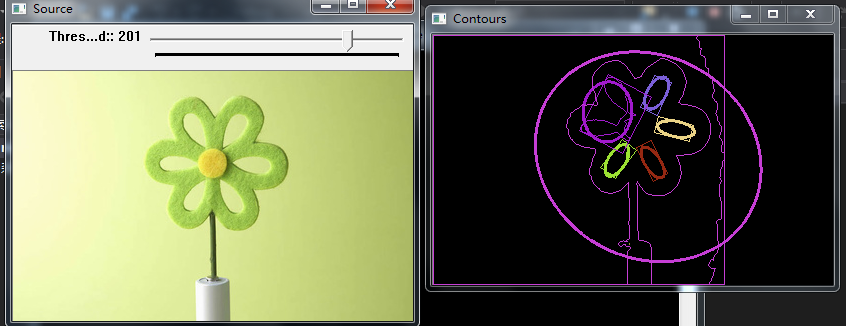
#include "opencv2/highgui/highgui.hpp" #include "opencv2/imgproc/imgproc.hpp" #include <iostream> #include <stdio.h> #include <stdlib.h> using namespace cv; using namespace std; Mat src; Mat src_gray; int thresh = 100; int max_thresh = 255; RNG rng(12345); /// Function header void thresh_callback(int, void*); /** @function main */ int main(int argc, char** argv) { /// 加载源图像 src = imread("E:\\VS2015Opencv\\vs2015\\project\\picture\\01.jpg"); /// 转为灰度图并模糊化 cvtColor(src, src_gray, CV_BGR2GRAY); blur(src_gray, src_gray, Size(3, 3)); /// 创建窗体 char* source_window = "Source"; namedWindow(source_window, CV_WINDOW_AUTOSIZE); imshow(source_window, src); createTrackbar(" Threshold:", "Source", &thresh, max_thresh, thresh_callback); thresh_callback(0, 0); waitKey(0); return(0); } /** @function thresh_callback */ void thresh_callback(int, void*) { Mat threshold_output; vector<vector<Point> > contours; vector<Vec4i> hierarchy; /// 阈值化检测边界 threshold(src_gray, threshold_output, thresh, 255, THRESH_BINARY); /// 寻找轮廓 findContours(threshold_output, contours, hierarchy, CV_RETR_TREE, CV_CHAIN_APPROX_SIMPLE, Point(0, 0)); /// 对每个找到的轮廓创建可倾斜的边界框和椭圆 vector<RotatedRect> minRect(contours.size()); vector<RotatedRect> minEllipse(contours.size()); for (int i = 0; i < contours.size(); i++) { minRect[i] = minAreaRect(Mat(contours[i])); if (contours[i].size() > 5) { minEllipse[i] = fitEllipse(Mat(contours[i])); } } /// 绘出轮廓及其可倾斜的边界框和边界椭圆 Mat drawing = Mat::zeros(threshold_output.size(), CV_8UC3); for (int i = 0; i < contours.size(); i++) { Scalar color = Scalar(rng.uniform(0, 255), rng.uniform(0, 255), rng.uniform(0, 255)); // contour drawContours(drawing, contours, i, color, 1, 8, vector<Vec4i>(), 0, Point()); // ellipse ellipse(drawing, minEllipse[i], color, 2, 8); // rotated rectangle Point2f rect_points[4]; minRect[i].points(rect_points); for (int j = 0; j < 4; j++) line(drawing, rect_points[j], rect_points[(j + 1) % 4], color, 1, 8); } /// 结果在窗体中显示 namedWindow("Contours", CV_WINDOW_AUTOSIZE); imshow("Contours", drawing); }





















 6650
6650











 被折叠的 条评论
为什么被折叠?
被折叠的 条评论
为什么被折叠?








